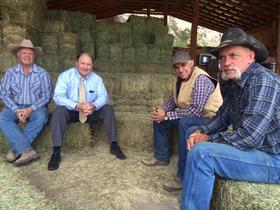Story by Aaron Granillo as reported on KNAU Arizona’s Public Radio
“A reader and fellow wild equine advocate brought this story to our attention and we definitely feel that it bears both repeating, here, and action taken upon. Please review the information at the bottom of the post” ~ R.T.
Larry Gibson is a third-generation rancher in Heber, Arizona. His barn is lined with dozens of haystacks – food for his 900 head of cattle. They also graze in the forest, but in recent years, Gibson says there hasn’t been as much to eat.

Cattle-rancher Larry Gibson (far right) sits inside his barn with fellow eastern Arizona ranchers. They argue the Heber Horses are overgrazing the Apache-Sitgreaves National Forests and need to be removed. Credit Aaron Granillo/KNAU
Cattle-rancher Larry Gibson (far right) sits inside his barn with fellow eastern Arizona ranchers. They argue the Heber Horses are overgrazing the Apache-Sitgreaves National Forests and need to be removed. Credit Aaron Granillo/KNAU”A lot of these areas, we go and measure the grass before the cows ever get there. There may be 80-percent usage before we ever get there,” Gibson says. “If the horses have eaten the feed, you can’t bring your cattle up.”
In his own lifetime – 57-years – Gibson claims that the wild horse population increase exponentially. He pays the Forest Service about $1,600 a month for grazing rights, and feels he’s not getting his money’s worth. Gibson believes there’s one solution to protect livelihood and land.
“So in my opinion, the best thing to with these up here would be remove every one of them. Whether they go to adoption, or, you know, I hate to say it, euthanized or to a slaughter plant,” Gibson says. “I mean that sounds kind of harsh, but something has to be done with them.”
That’s something horse advocate and photographer Mary Hauser won’t accept.
“I don’t have any problem with these ranchers. They’re making a living.” Hauser says. “But I don’t think that our land should be stripped of our heritage and our wild horses.”
Hauser has been taking pictures of the Heber horses for the past 14-years. On a recent afternoon, she drives to their official territory, established after the Federal Wild Free-Roaming Horses and Burros Act of 1971. It’s meant to protect them from sale or slaughter.
Hauser believes the horses she sees through her camera lens are related to a herd of Spanish mustangs brought to the Southwest centuries ago.
“Characteristically, they have an almond shaped eye. The shorter back. Their nostrils are thinner as far as the texture and thickness of the skin,” Hauser says. “And that’s all the Spanish look. So that tells me that these horses really are carrying the blood of those Spanish horses.”
Historian Jo Baeza suspects that may have been true at the time the Federal horse act was established.
“In 1540, Francisco Vázquez De Coronado came through the White Mountains with a huge entourage. Thousands of horses,” Baeza says. “I believe that those were the original horses of the Mogollon Rim — the descendants of Coronado’s herd.”…(CONTINUED)
The Rest of the Story
Welfare Rancher Larry Gibson works for the Seibert Cattle Company LLC which has federal lands grazing leases in several states. Gibson runs Seibert cattle on the Heber Grazing Allotment where many of the Heber wild horses live. Part of the grazing allotment covers nearly half of the dedicated Heber Wild Horse Territory in the Apache-Sitgreaves National Forests in Arizona.
Gibson claims the wild horse population has increased exponentially over the years. However, the last two USFS aerial counts from 2014 and 2015 show the population of the herd in and around the Heber Wild Horse Territory to be approximately 202, which is down over 100 horses from 2005 when a previous wild horse roundup was stopped by a court order. According to USFS the total 2015 count for the entire 2.7 million acre Apache-Sitgreaves Forests was 320.
The Heber grazing allotment renewal EA coincidentally was just recently released and calls for increasing the amount of cattle to be grazed. This grazing allotment calls for structural and non-structural improvements costing approximately $4 million dollars without saying how much of that economic burden will be placed on the American tax payer. Public comments are now open through Friday, June 12, 2015.
Please take a look at the Heber Allotment Draft Environmental Assessment
Please mail your public comments to:
Black Mesa Ranger District
Attn: Chris James
2748 Highway 260
PO Box 968
Overgaard, Arizona 85933
Attn: Chris James
2748 Highway 260
PO Box 968
Overgaard, Arizona 85933
OR you can follow the instructions to email your comments:
US Forest Service
Black Mesa Ranger District
2748 East Highway 260
PO Box 968
Overgaard, Arizona 85933
Black Mesa Ranger District
2748 East Highway 260
PO Box 968
Overgaard, Arizona 85933
Attn: Dawnee Burson
dlburson@fs.fed.us
dlburson@fs.fed.us
Heber Allotment Analysis #43442
Commenting on This Project
https://cara.ecosystem-management.org/Public//CommentInput?Project=43442be
https://cara.ecosystem-management.org/Public//CommentInput?Project=43442be
Heber Allotment Analysis:
http://www.fs.usda.gov/project/?project=43442&exp=overview
http://www.fs.usda.gov/project/?project=43442&exp=overview
More Information:
The Heber Wild Horse Territory Notice Of Intent (NOI) is soon to be released with public commenting to follow. This will state the Forest Service plans for any Heber wild horse removal.









No comments:
Post a Comment